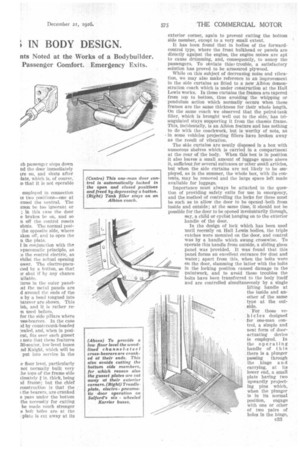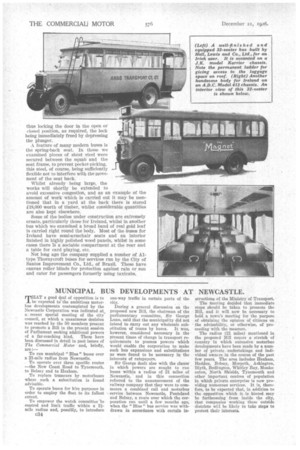MODERN TENDEN■ ; IN BODY DESIGN.
Page 54

Page 55

Page 56

If you've noticed an error in this article please click here to report it so we can fix it.
Where Improvements are being Effected Electro-pneumatic Door Control. Stu nts Noted at the Works of a Bodybuilder. Passenger Comfort. Emergency Exits.
Constructional feat some of the lates of body. APART from a few outstanding types of body, such as those particularly intended for all-weather service, the design of buses and coaches may be said to have become almost standardized—at least, so far as would appear by exterior observation—but in the actual detail construction of such bodies constant improvement is being effected, and it is essential for both the user and the chassis builder to keep track of these modifications so that the bodies employed are up to date in, every detail.
The great call for low load-line chassis and, now, the rapid development of the six-wheeler have presented problems which must be elucidated by the body builder, and it was with a view to obtaining information on some of these that we recently paid a visit to the coachbuilding works of Hall, Lewis and Co., Ltd., at Park Royal, London, N.W.10. Here we found the works practically congested with bodies in all stages of construction, and it was a good sign of the flourishing condition, of the commercial-vehicle market that many were held up because chassis were not available.
Apart from this, the influx of orders is a recognition of merit, for not only is the workmanship excellent, but the materials employed are themselves in the first category. For instance, nothing but English ash is used for the body framing and English oak for the bearers, whilst the panelling is carried out in silver' finished steel, which is practically non-rusting and, Consequently, overcomes many of the problems which at present occur where such special material is not employed. Again, for the upholstery, nothing else but leather is employed; this is, of course, so far as the standard specification is concerned, as buyers must, of course, be allowed their own way, and if they should demand an imitation leather it must necessarily be supplied.
We were extremely interested to notice a number of single-deck buses on Karrier and Guy six-wheeler chassis, and on the Karrier buses for Salford we found that arrangements are being made for operating the entrance and exit doors by pneumatic power, the system employed being developed by G. D. Peters, Ltd., Caxton House, Westminster, London, &W.1.
The entrance door is at the near-side rear and the exit at the near-side front. That at the back can be controlled from either end of the vehicle by means of a key operating a special valve, and so arranged that the valve must be left in the correct position or the key cannot be extracted. The pneumatic engines, as they are termed, are operated by air from the air-brake cylinder, and there is interconnec tion between the brake operating mechanism a n
that controlling
the doors.
Dealing first with the entrance door, the actuation of this depends upon the brakes. It can not be opened un less the brakes are on; likewise, both loors. are shut automatically if left open when the vehicle starts, but in such a case the doors will open when the brakes are applied. This is only a precau tionary measure, and it is not in tended that the doors should be Shut automatic ally.
032 In alighting from tb on to a hinged treadh opens, providing the the person leaves the situated inside the en from outside.
A two-way control with this exit. This each side of what at first is only employe( too light to operate will open automatica soon as the brakes itself in neutral and 1 tion of the control va ,it stays until the bral door it is necessary The control inechai treadle plate is on 1.1 it is found more rapi there is no lag in th( is performed by pnei ma tie valve can also the door can still be the electric power b
One of the Hall L ling of their bus bod carried over the wais waist rail, being finis the woO, so that no ;s. makes an extremely markable that it btu Gusset plates are.e] they Join the roof rai of the roof gusset this parallel screws which tion, an elbow piece, plate. It will be of h were found on two M built for Messrs. Fall the first of this mal Metropolis.
To obtain the low& on those chassis wh low, the cross-bearers members, cork pa ck in used between the lx feature of interest channel members, whi at each end, so that side members, thus these. The gussets ( through this measur bottom of each. Eac .ch passenger steps down ad the door immediately ire on, and shuts after late, which is, of course,. a) that it is not operable employed in connection ts two positions—one at ;rmed the neutral. The ;rson be too ignorant or ; in this case the door e brakes be on, and so n off the. control resets shuts. The normal posithe opposite side, where aken oil', and to open the n the plate.
I in conjunction with the )-pnenmatic principle, as the control electric, as vhilst the actual opening ower. The electro-pneutted by a button, so that )1. shut if by any chance Lures in the outer panel[at the metal panels are d around the ends of the e by a bead tongued into ha Lever are shown. This ish, and it is rather rem used before.
for the side pillars where .oss-bearers. In the case ad by countersunk-headed :wiled, and, when in postcut, fits over each gusset ) note that these features 30-seater, lowlevel buses .nfl Knight, which will be put into service in the .e floor level, particularly not normally built very :he tops of the frame side (imately in. thick, being xl frame'; but the chief construction is that the ; the bearers, are cranked s pass under the bottom the necessity for cutting be made nuic.h stronger e bolt hales are at the 'plate is cut away at its exterior corner, again to prevent cutting the bottom side member, except to a very small extent.
It has been found that in bodies of the forwardcontrol type, where the front bulkhead or panels are directly against the engine, the engine noises are apt to cause drumming, and, consequently, to annoy the passengers. To obviate this trouble, a satisfactory solution has proved to be armoured plywood.
While on this subject of decreasing noise and vibration, we may also make reference to an improvement in the side curtains as fitted to a new Albion demonstration coach which is under construction at the Hall Lewis works. In these curtains the frames are tapered from top to bottom, thus avoiding the whipping or pendulum action which normally occurs when these frames are the same thickness for their whole length. On the same coach we observed that the petrol-tank filler, which is brought well out to the side,has triangulated stays supporting it from the chassis frame. This, incidentally, is an Albion feature and has nothing to do with the coachwork, but is worthy of note, as in some vehicles projecting fillers have broken away as the result of vibration,
The side curtains are neatly disposed in a box with numerous shelves which is carried in a compartment at the rear of the body. When this box is in position it also leaves a small amount of luggage space above it, sufficient for several suitcases or other small articles, but when the side curtains are not likely to be employed, as in the summer, the whole box, with its contents, may he removed and the large space left made available for luggage.
Importance must always be attached to the question of providing safety exits for use in emergency, and the method of controlling the locks for these must be such as to allow the door to be opened :both from inside and outside; at the same time, it should not be possible for the door to be opened involuntarily through, say, a child or cyclist hanging on to the exterior handle of the door.
In the design of lock which has been used until recently on Hall Lewis bodies, the triple catches were mounted on the door, and control was by a handle which swung crosswise. To operate this handle from outside, a sliding glass panel was Provided. It was found that this panel forms an excellent entrance for dust and water; apart from this, when the bolls were on the door, slamming the latter with the bolts in the locking position caused damage to the paintwork, and to avoid these troubles the bolts have been transferred to the body itself and are controlled simultaneously by a single Lifting handle at the inside and another of the same type at the outside.
For those vehicles designed for one-man control, a simple and neat form of door'actuating device is employed. In the operating handle of this there is a plunger passing through the hinge an d carrying, at its lower end, a small plate having two upwardly projecting pins which, when the plunger is in its normal position, engage with one or other of two pairs of hole in the hinge, thus locking the door in the open or closed position, as required, the lock being immediately freed by depressing the plunger.
A feature of many modern buses is the spring-back seat. In those we examined pieces of sheet steel were secured between the squab and the seat frame, to prevent pocket-picking, this steel, of course, being sufficiently flexible not to interfere with the movement of the seat back.
Whilst already being large, the works will shortly be extended to avoid excessive congestion, and as an example of the amount of work which is carried out it may be mentioned that in a yard at the back there is stored f 18,000 worth of timber, whilst considerable quantities are also kept elsewhere.
Some of the bodies under construction are extremely ornate, particularly those for Ireland, whilst in another bus which we examined a broad band of real gold leaf is carried right round the body. Most of the buses for Ireland have semi-armchair seats and an interior finished in highly polished wood panels, whilst in some cases there JS a sociable compartment at the rear and a table for card playing, etc.
Not long ago the company supplied a number of Altype Thornycroft buses for services rtm by the City of Santos Improvement Co., Ltd., of Brazil. These have canvas roller blinds for protection against rain or sun and cater for passengers formerly using taxicabs.












































































































